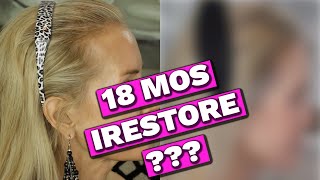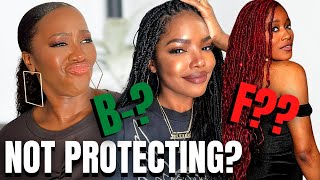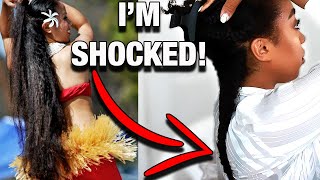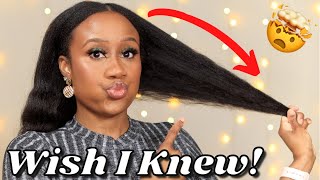My Experience With Traction Alopecia
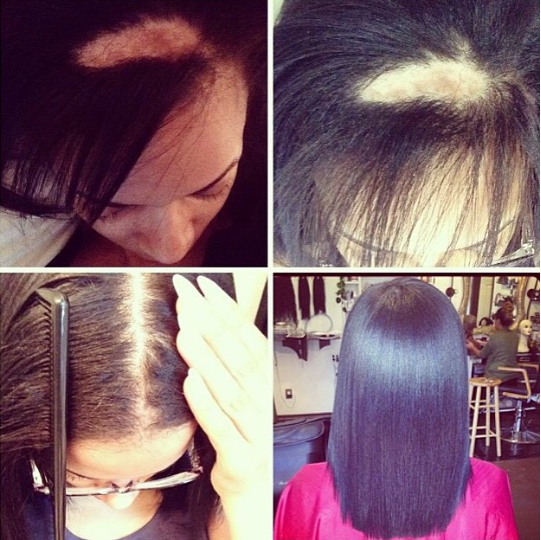
I was a serial hair puller; I would wear tight buns and ponytails during the day then tightly tie my scarf around my edges at night. I liked to wear my hair a little tighter simply because it looked neater and felt more secure when I was wearing extensions* or clip ins*. It wasn’t until I started to experience breakage at the nape–or the kitchen– of my neck that I knew I had to give up my tight hairstyles.
I eventually managed to grow back my hair, but after it was all grown in, I made the mistake of going to the salon and getting some super long box braids. I asked the stylist to make the braids loose around my edges–and she did–but the way they were installed plus the weight of the braids were entirely too much for the nape of my neck.
After only two weeks of having the braids in, my hair began to weaken and rip out to the point that whole braids were falling out the back because they no longer had anything to grip onto. Of course, I was distraught, but it was my own fault for thinking my hair could withstand all of that tension.
After all was said and done, I had less than an inch of hair in the back of my head and no clue how to grow it back, so I did some research and found out that I was experiencing traction alopecia.
Traction alopecia is gradual hair loss caused by harsh tugging or pulling while wearing tight hairstyles. A lot of women are not able to grow their hair back after traction alopecia because while their hair was being pulled, the follicles were being damaged and/or destroyed.
When I read that, I went into a full blown panic because I thought my hair was never going to grow back. However, I continued to do research and I learned that if the affected spot was bald, shiny, and clearly missing hair follicles then it was pretty obvious that I could no longer grow hair there. Luckily for me, I had some hair left so there was a chance that I could grow it back.
For the next two years, I wore nothing but sew ins. In hindsight, that sounds crazy considering all the tugging and pulling that comes with a sew in; but I knew that the edges and crown area of my hair were strong so I could wear weaves* without damage. For each install, I left out the nape of my neck and wouldn’t do anything to it except apply Jamaican black castor oil*, wash, and repeat.
It took about two years for my hair in the back to grow long enough to put into a high ponytail, but considering how short it was before, I was very happy with the growth.
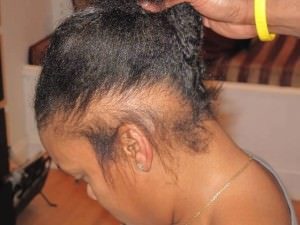 There were a bunch of crazy facts and information about traction alopecia but the most startling one was that it was very common for Black women because of how we style our hair.
There were a bunch of crazy facts and information about traction alopecia but the most startling one was that it was very common for Black women because of how we style our hair.
Traction alopecia is preventable and can be reversed as long as you are patient and dedicated to taking care of your hair. If you currently are dealing with traction alopecia or would like to prevent it from happening, below are a few tips to help you out!
Listen To Your Hair
When your hair is being harshly pulled and yanked, it will respond with itching, burning, pain, or breakage. If you notice any of these things, that is your cue to loosen your hairstyle. If you are unsure of how to adjust your style so that it will no longer pull on your hair, look into low manipulation protective styles.
If you’re already dealing with traction alopecia, stop all habits that caused the problem and wear a style that doesn’t bother the affected area like a wash-and-go or loose twists.
Have A Stimulating and Strengthening Hair Regimen
Massaging your scalp with oils*, using protein treatments and hair masks, etc. on top of your normal regimen will help your hair grow in healthy and strong. It’s also a great way to protect the rest of your hair from damage.
No, there is no quick fix product or routine for traction alopecia but the right hair regimen is absolutely beneficial to consistent growth of healthy hair.
Know Your Hair’s Limitations
Even though I went through traction alopecia years ago, my hair is still too fragile for box braids and will probably always be–so I stay away from heavy styles and let my hair flourish in weaves* and natural afros most of the time.
Knowing what you can and can’t do will save you a world of trouble when it comes to your hair. If you like a hairstyle but can’t wear it because it’s too hard on your hair, then don’t wear it! Don’t sacrifice the health and vitality of your hair for a temporary style.

